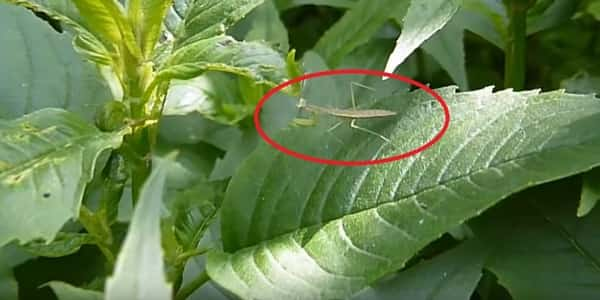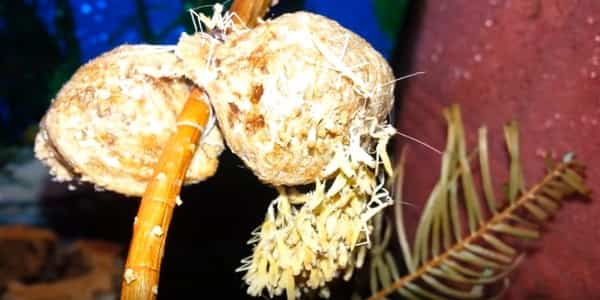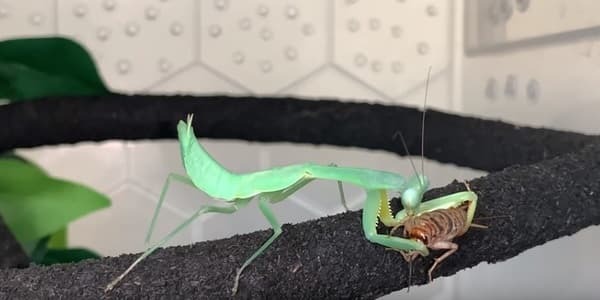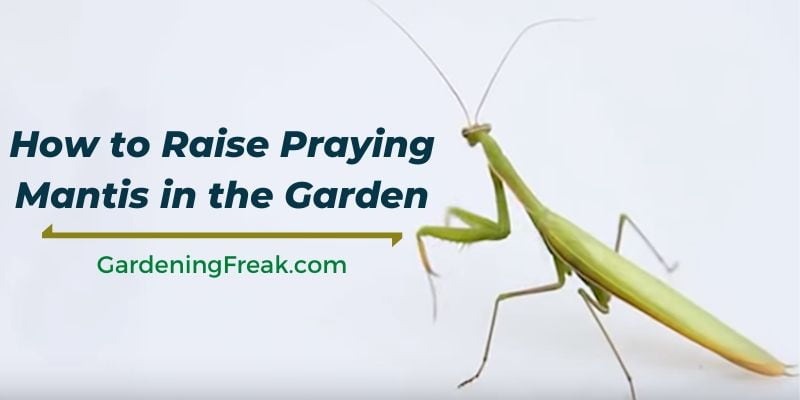The praying mantis is one of the most beneficial insects to have in your garden. It is an adored predator that eats most of the pests, mites, and eggs in your garden. Hence, most gardeners like to grow their own praying mantises in order to get rid of problematic pests and insects. The praying mantis is usually called the ‘extreme predator’. Apart from this, a praying mantis is popular for its Voracious Appetite. That means it will spend days hunting for other insects without getting tired. Hence, it is like having a tireless insect-killing machine in your garden. Both young praying mantis and more mature ones help you clear the garden out. This article is all about helping you understand what a praying mantis is, how it benefits your garden and How to raise praying mantis in the garden
How to raise praying mantis in the garden
In this article we’ll try to cover everything related to praying mantis. But our main focus will be help our reader to understand How to raise praying mantis inside garden. There is several ways to raise praying mantis. Some of the most effective way to do this is listed bellow
1. Find a praying mantis in your yard and attract them inside your garden

Finding a praying mantis or praying mantis eggs on your plants is almost impossible because of their amazing camouflaging abilities. However, adult mantids can be spotted every now and then on flowering plants and porch lights near September. If you are looking to inhabit your garden with praying mantises, the first step is to look for mantises already there. In most cases, organic gardens are inhabited by praying mantises. However, if you have been using pesticides and insecticides, there is a huge chance you don’t have praying mantises in your garden.
If you don’t already have a praying mantis population in the garden, the best way to attract them is by creating a bug friendly environment. This can be done using plants belonging to the rose or raspberry family as well as tall grasses and shrubbery where they can seek shelter. Moreover, you can also look for egg cases in your garden. If you find an egg case outside the garden, you can cut the branch (at least 1 feet) and transfer it to the garden. If all of these things fail, you can buy adult mantids or praying mantis eggs from the local gardening store and raise them for your garden.
2. Use Plants that attract praying mantis

When it comes to attracting praying mantises, there are a few plants that they prefer residing in. however, before jumping to the types of plants that you need for attracting praying mantises, it is important that your garden is completely organic. If you have used pesticides and insecticides, no matter what you do, the praying mantis will not come to your garden. Once you have established an organic garden, the type of plants that you can use to attract a significant praying mantis population is:
- Angelica
- Cosmos
- Yarrow
- Marigold
- Raspberry canes
- Culinary herbs (dill, caraway, and fennel).
Apart from this, other things you can do to attract praying mantises to your garden include:
- Fill shallow dishes with layers of rocks and pebbles, and add water to it to cover the bottom. Praying mantises enjoy drinking water from such areas.
- Praying mantises are individual insects and need to take cover during the day, provide longer grass and shrubs so that they can hide in them during the day.
- Spray the plants and grass with artificial insect attractants.
3. Hatch praying mantis eggs inside garden

If despite all your efforts, you are not able to attract praying mantises to your garden, it is better to invest in praying mantis eggs and let them hatch in your garden. This way, the insects will grow up there and consider it as their home.
3.1 Purchasing eggs

You can easily purchase praying mantis eggs from the local gardening store. In case they don’t deal with such things, you can find a glut of sellers dealing with egg cases of beneficial insects. In some cases, you might even find vendors selling grown-up mantises that are ready to prey in your garden. A single egg case comes with at least 200 eggs, which is enough to cover 1500 square feet area.
3.2 Placing the mantis eggs to the garden

Before putting the mantis eggs in the garden, it is important to see if it is warm outside. If not, store the eggs in the fridge and let the weather warm up. Once you get nice and cozy weather, find a twig or a tree branch that has a good leaf cover and is one or two feet above the ground. Attach the egg case with the branch and let it rest there. After 10 to 15 days, the eggs will start hatching. You will see individual mantises ready to catch their first prey in as much as 20 days. Don’t place the egg cases directly on the ground, and ants will end up eating the baby mantises. Moreover, it is important to keep the mantises near to a food source or else they will start eating each other.
3.3 Baby praying mantis food

If you are raising your own mantises, it is extremely important to understand what baby mantises eat. As soon as the baby mantises hatch, they immediately start eating. Initially, they feed on small insects with soft bodies but as they grow up, they rely on more than one type of food. Baby praying mantises are not very much ready to get into the preying world. Hence they survive on small insects since they are abundant in number and can be easily found in summers. This is why eggs hatch in warmer weather.
As they grow slightly, the baby praying mantises move on from small insects to aphids and caterpillars. However, as they grow old, they can consume anything and everything from beetles, moths, small mice to other praying mantises. Hence, experts advise that it is ideal to have both small and mature, praying mantises in your garden. The adults have a hard time eating small insects because they cannot capture them in their forelegs. Thus, to rid your garden of small and large-sized insects, it is better to have baby and mature praying mantises in your garden. Moreover, at the time of hatching, make sure you keep a water source near the hatching area. Praying mantises drink a lot of water and it is crucial for their development.
What does a praying mantis eat normally
As mentioned, praying mantises are voracious eaters. They have a large appetite and eat an array of insects including leafhoppers, aphids, flies, crickets, grasshoppers, spiders, other mantids, small tree frogs, lizards, mice and the sometimes hummingbirds. Hence, providing food for these carnivores is not as difficult as you think it is. It can be easily done by trapping insect-like flies and moths, and releasing them in the mantis container (if you are raising them by yourself). In case you have naturally attracted the mantises to your garden, you don’t have to worry about their food. These insects come with an extraordinary preying mechanism and can get food for themselves one way or another.

It uses its forelegs to catch the prey like a tweezer. However, praying mantises are known to avoid insects that are dead. Apart from this, they cannot catch insects that are very small. Hence, they cannot eat ants and similarly sized insects and pests. Thanks to their camouflage, most of the insects in the garden don’t see them, and the praying mantis does not have a hard time catching food.
Why it is important: the benefits of praying mantis in the garden

Many gardeners, especially newbies, are not at all aware when it comes to the benefits of releasing or attracting praying mantises in your garden. Some of the benefits of having praying mantis in your garden are:
Pest control
As mentioned, praying mantises are voracious eaters. Hence, they devour any and every insect that comes in front of them. In rare cases, if there is a lack of food, they even eat fellow praying mantises. Young praying mantises eat soft insects like caterpillars and aphids while the more mature ones eat all kinds of insects including crickets, grasshoppers and beetles.
Natural
Gardeners can also use pesticides and insecticides to control the pest, but that is not the natural way. Unfortunately, pesticides and insecticides come with a number of side effects. This not only affects the health of plants but also affects the overall health of the fruit. Moreover, pesticides and insecticides don’t work for all kinds of pests and insects. However, when it comes to a praying mantis, it is not only natural but also eats up all kinds of insects and pests. Thus, releasing a praying mantis in your garden is much more efficient as compared to insecticides and pesticides.
Prey day and night
Praying mantises are known for their tireless work. On top of eating anything and everything, these insects work day and night looking for prey. It can be mosquitos, flies, moths, roaches, insect eggs, etc. Hence, it not only finishes up pests infesting your garden but also gets rid of the eggs curbing the chances of another generation of pests. Moths, that are not covered by most pesticides and insecticides can be controlled by the help of mantises.
Interesting facts about praying mantis
On top of being extremely beneficial for the garden, praying mantises are pretty interesting as well. Before go through deep inside the topics lets check some mind blowing statistics about praying mantis
| Attribute | Numerical Statistics | Detail Explanation |
| Number of Species | Around 2400 | Due to their special disguise ability human can only discover 2400 of species. But it is assumed that there are still a lot of undiscovered varieties exist in the tropical area |
| Number of Genera and Families | Around 430 and 15 respectively | Praying Mantis is the largest among these 15 families |
| Vision | Special 3-D Vision | They Have Strong 3-D Stereo vision like humen |
Some more interesting facts about these insects are:
- Praying mantises are carnivores, and like most insects, they come in numerous species. Out of all the species the most common are European mantis, Carolina mantis, and Chinese mantis
- Their front legs look like they are held up in prayer (this is where the name comes from). However, they are actually designed like this for catching prey rapidly.
- These are the only insects that can move their heads from side to side by 180 degrees.
- They can catch the slightest movement from as far as 60 feet.
- A praying mantis has five eyes, but only one ear, so it is slightly short of hearing.
FAQs
Having praying mantises in your garden is very beneficial, but unfortunately, newbies struggle with this. Hence, we have combined a list of frequently asked questions to make the whole process easier.
Do praying mantises to cost a lot?
No, praying mantises are not very costly; however, in some areas, you might have a hard time finding them. Moreover, you need a new batch every summer season.
When do praying mantises lay eggs in the wild?
One generation of praying mantises develop every season. The females lay eggs in autumn. These eggs are in clusters. Usually, 1-inch long and have a frothy or gummy covering through which they are attached to twigs and tree branches.
Can praying mantis eggs be relocated?
Yes, they can be easily relocated, but make sure you don’t place the cocoon-like structure on the ground. Also, don’t place it in a cold and moist area. Place the eggs near ample food and water source though.
How many eggs do I need for my garden?
This completely depends on the size of the garden. Usually, 600 eggs are enough for a 5000 square feet garden. You can do the math now.
Conclusion
Praying mantis plays an important role in the ecosystem of your garden. They are a great source of keeping your crops pest and insect free naturally. When it comes to growing organic fruits and vegetables, there is no better way then investing in praying mantis eggs. As mentioned, these carnivores eat anything and everything that is harmful to your garden. However, make sure there is a proper food source for the mantises or else they will start eating each other. Apart from praying mantises, ladybugs are also very beneficial for our garden. There are several ways to attract ladybugs inside the garden. So you can look into them as well. So that’s all for today. Hopefully, you already get a brief guideline and understanding about how to raise praying mantis in the garden after go through this article.















[…] The truth is that slugs can cause potential damage to your hostas if you do not act fast. They can make you lose your precious Hostas garden and end up looking like a failed gardener. Getting rid of them can also be costly and frustrating. But this doesn’t have to be you. Dealing with slugs on hostas is made much easier with our guide that tells you everything you should know about dealing with slugs on hostas. Using natural methods to prevent them completely, you do not have to struggle with maintaining slug-free hostas anymore. You can now enjoy slug-free hostas at all times. That’s all from this article about how to get rid of slugs on hostas. Like slugs, different kinds of harmful insect also do a lot of damage for our garden. That can be easily controlled by a beneficial insect like praying mantis. So besides this article if you want to know more about them can read our this article […]